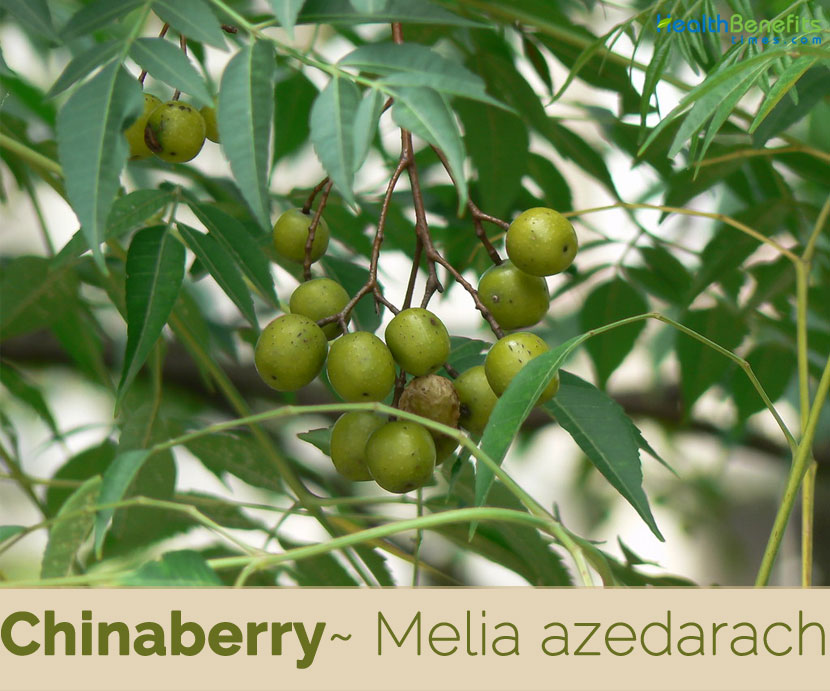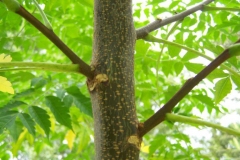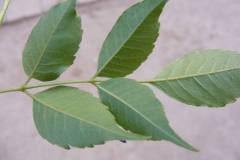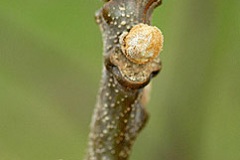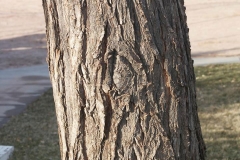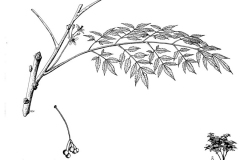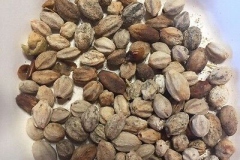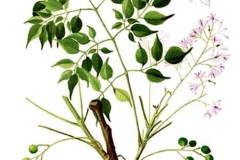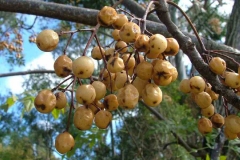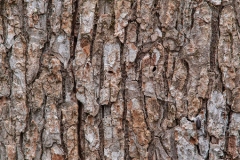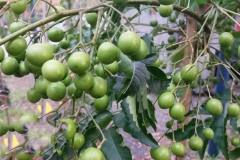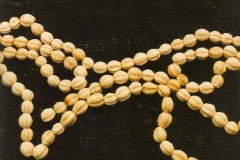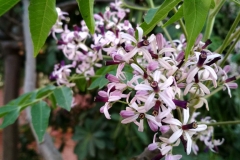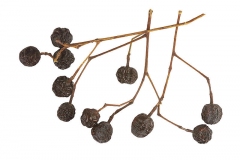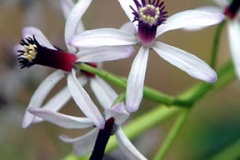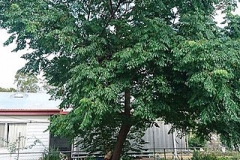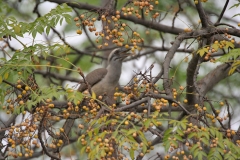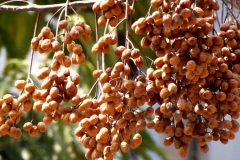| Chinaberry Quick Facts | |
|---|---|
| Name: | Chinaberry |
| Scientific Name: | Melia azedarach |
| Origin | China, Japan, the Indian sub-continent, south-eastern Asia and large parts of northern and eastern Australia |
| Colors | Greenish yellow to yellowish tan |
| Shapes | Globose to sub globose drupe about 0.4 to 0.8 inches (1-2 cm) in diameter, but may be as much as 2 inches (5 cm) wide |
| Taste | Bitter, sour, astringent |
| Health benefits | Beneficial for rheumatism, neuralgia, nervous headache, ringworm, gum diseases, piles, dandruff, gout, asthma, gastroenteritis, giddiness, vertigo, ascariasis |
| Name | Chinaberry |
|---|---|
| Scientific Name | Melia azedarach |
| Native | China, Japan, the Indian sub-continent, south-eastern Asia and large parts of northern and eastern Australia |
| Common Names | Cape-lilac, Chinaberry, Indian lilac, Persian lilac, Sichuan pagoda tree, Texas umbrella-tree, bead tree, chinaberry-tree, margosa tree, pride of India, syringa berrytree, tulip-cedar, umbrella-cedar, umbrella-tree, white cedar, Bastard Cedar, Bakain, Drek, Deikna |
| Name in Other Languages | Afrikaans: Bessieboom, Bessieboom syringa, Maksering, Thamanga Seringboom, Ghora neem Albanian: Melie, Chinaberry Amharic: Chayininya (ቻይንኛ) Arabic : Azadirikhat (أزادرخت), ‘azidarakhat shayie (أزدرخت شائع), tshinabri (تشينابري) Armenian: Chinaberry Assamese: Ghora nim (ঘোঁৰা নিম), Khammaga Azerbaijani: Cinaberry Bangladesh: Goda neem Bengali: Bakarjam, Ghoranima (ঘোড়ানিম), Mahanim, Gora-Nim Brazil: Arvore-santa, cinamomo, jasmim-de-cachorro, jasmim-de-soldado, lilás-da-India, para-raios Bulgarian: khimalaĭska meliya (хималайска мелия) Burmese: Tarotepyi (တရုတ်ပြည်) Cambodia: Dâk’ hiën, sdau khmaôch Catalan: Arbre de sabonetes, Arbre sant, Lilà de les Índies, Llessamí d’amèrica, Metzina, Mèlia, Rosarier, amèlia, arbre de grau de Rosari, arbre de sabonetes, arbre del Paradis, arbre sant, gessamí d’Amèrica, lilà de Pérsia, parenostre, xuclamoro Chamorro: Paráisu, paraiso Chichewa: Ndya Chinese: Chuan lian, Lian (楝), Lian chu (楝树), Chuan liang zi, Ku lian pi, liàn shǔ (楝属), Zhōngguó méi (中国莓), Sen shu, Jin ling zi Croatian : Melija, Očenašica, kok, Perzijska očenašica, chinaberry, Czech: Zederach hladký, chinaberry Danish: Paternostertræ, Chinaberry Dutch: Kralenboom, Indische sering, galbessen, paternosterboom, chinaberry, English: Barbados lilac, Bastard cedar, Bead tree, Cape lilac, Chinaberry, Chinaberry tree, Ceylon cedar, Ceylon mahogany, Hoop tree, Indian bead tree, Indian lilac, Persian lilac, Pride of China, Pride of India, Sichuan pagoda tree, Syringa berry tree, Texas umbrella tree, Tulip cedar, Umbrella cedar, Umbrella tree, White cedar , Persian-lilac, Sichuan pagoda-tree, Sichuan pagoda-tree, Lelah, Paraiso, Umbrella-cedar, Syringa, seringa Esperanto: Bida melio, chinaberry Estonian: Chinaberry Fijian: Bakain, dake Filipino: Tsinaberry, Paraiso, Bagaluñga, Balagañgo Finnish: Meelia, chinaberry French: Acacie d’Égypte, Adrézarach, Arbre à chapelets, Arbe margousier, Azédarac, Azédarach, Cascarelle, Cormier des indes, Lilas de Perse, Lilas des Indes, Margousier, Mélie Pater-noster, Arbre à chapelets, lilas de Chine, faux sycamore, laurier grec, lilas des Antilles, patenôtre, pater noster, chinaberry Galician: Árbore de Santo Outelo Georgian: Chinaberry (CHīnəˌberē) German: Chinesische Holunder, Chinesischer Holunder, Indianischer Lilak, Indischer Zederachbaum, Indischer Zedrachbaum, Paternosterbaum, Persischer Flieder, Zedrachbaum, Paradiesbaum, Perlenbaum Greek: Agriopaschaliá (Αγριοπασχαλιά), Louloudiá (Λουλουδιά), Mélia, Meliá (Μέλια, Μελιά), Moschokarfia (Μοσχοκαρφια), Paschaliá (Πασχαλιά), Pseudomelia (Ψευδομέλια), Ψευδομελιά Pseudomelia (Ψευδομελιά), Solomós (Σολομός), Mavrommata, Pseudopaschalia, kinéziko (κινέζικο) Gujarati: Cinābērī (ચિનાબેરી), Bakan Limado, Bakai Nimbu Haitian: Lilas peyi Hausa: Chinaberry Hawaiian: Ilinia, ‘inia Hebrew : אזדרכת מצויה, Eazdarehet metzuya, אזדרכת מצויה Hindi: Bakain (बकैन), Bakānā nīmba (बकाना नीम्ब), bakayan (बकायन)Bakayan, Mahanimb (महानीम), Bakarja, arebevu, bakam-limdo, bakarja, bakarjan, bakayan, bakon-limdi, betain, bokain, chik-bevu, deikna, dek, deknoi, drek, ghora nim, gowdnim, heb-bevu, hutchubevu, kadbevu, kaliyapa, karin vembu, kattu veppu, mahaneem, makanim, malla nim, mallay vembu, padrai, pejri, puvempu, sima veppu, taraka-vepa, thamaga, thurakavepa, turka, vaymbu, vilayati nim, yerri-vepa Hungarian: Chinaberry Icelandic: Kínberja Indonesian: Mindi, gringging, marambung, mindi kecil Irish: Chinaberry Italian: Albero da rosari, Albero dei rosari, Albero dei paternostri, Lillà delle Indie, Perlaro, albero della pazienza, perlaro, sicomoro falso, chinaberry Japanese: Sendan (センダン), Sendan (せんだん), Chainaberi (チャイナベリ) Javanese: Chinaberry, Gringging Karbi: Neem tita Kannada: Kadu Bevu (ಕಾಡು ಬೇವು), Kiṟubēvu/kirubēvu (ಕಿಱುಬೇವು/ಕಿರುಬೇವು), Caināberi (ಚೈನಾಬೆರಿ), Kadu Bevu, Heb bevu Kazakh: Chinaberiya (чинаберия) Khmer: Dâk’hiën, Sadau khmaôch Korean: Meol gu seul na mu (멀구슬나무), chaina beli (차이나 베리) Kurdish: Chinaberry Kwara‘ae: Buriakalo Laotian: H’ienx, Kadau s’a:ngz, chinaberry (CHīnəˌberē) Latin: Chinaberry Latvian: Kīniešu Lithuanian: Chinaberry Macedonian: Cinaberi (чинабери) Malagasy: Chinaberry Malay: Gringging, Marambung, Mindi, Mindi kecil, chinaberry Malayalam: Malaveppu, śīmavēpp (ശീമവേപ്പ്), cainabeṟi (ചൈനബെറി), Aryaveppu, Malaveppu, Valiyaveppu, Kattuveppu Maltese: Siġra tat-tosku, Chinaberry Mangarevan: Paina Manipuri: Seizrak Maori (Cook Islands): Tīra Marathi: Bakan nimb (बकाणनिंब), chinaberee (चिनबेरी), Bakenu, Khaibasi Mishing: Abori esing Mizo: Sakhi-thei Mongolian: Cinaʙerri (чинаберри) Nan: Khó͘-lēng Nauruan: Gadong, gadung Nepali: Bakenu, Bakā’inō (बकाइनो), Bakenu (बकेनु), Bakaaino (बकाइनो), Mahaaneem (महानीम), chinaberee (चिनबेरी) Netherlands: Galbessen, paternosterboom Newari: Khaibasi (खाईबसी) Niuean: Sili, tili Norwegian: Paternostertre, Chinaberry Occitan: Azedrà Oriya: ଚିନାବେରୀ | Pakistan: Bakain, white cedar Pashto: چینابری Persian: زنزلخت Zanzalakht, آزاددرخت Philippines: Bagaluñga, balagañgo, paraiso Pnb: دریک Pohnpeian: Lelah Polish: Miotla, Chinaberry Portuguese: Amargoseira, Amargoseira-do-Himalaio, Árvore-santa, Cinamomo (Brazil), Conteira, Lilás-da-Índia, Lilás-das-Índias, Margoseira-do-Himalaio, Mélia, Paraíso, Sabonete-de-soldado, Chá-de-soldado, Jasmim-de-caiena, Lilás-de-soldado, Loureiro-grego, Santa-bárbara, Sinamomo , Neem Silvestre, agrião, amargoseira-bastarda, azedaraque, azufeifo, conteira, falso-sicómoro, mélia-dos-himaláias, sicómoro-bastardo, árvore-dos-rosários Punjabi: Deka (ਡੇਕ), Cinabērī (ਚਿਨਬੇਰੀ), Dharek, Bakain, Drek Romanian: Chinaberry Russian: Мелия азедарах, chinaberry (CHīnəˌberē) Sanskrit: Mahanimbah (महानिंब), Mahānimba sasyam (महानिम्बिसस्यम्), Ramyaka, Dreka, Maha nimba, Nimbaraka, Karmuka, Visa mustika, Girika, Udreka, Kshira and Kesha Mushtika, Arista, Brihannimba and Parvatanimba Serbian: Chinaberri (цхинаберри) Sindhi: چنبيري Singapore: Mindi kechil Sinhala: Cayināberi (චයිනාබෙරි) Slovene: Indijska lipovka, chinaberry Spanish: Agriaz, Agrión, Árbol de los rosarios, Arbol del para, Árbol del Paraíso, Árbol santo, Azedaraque, Cinamomo, Flor del paraiso, Melia, Paraíso, Paraíso sombrilla, Piocha, Rosariera, Acederaque, Alelí, Cinamon, Cinamono, Fruto del paraíso, Mirabobo, canelo, lila, paraiso, San Jacinto, jasmine de Arabia, Jazmin, acederaque, aleli, bolillero, canelo, falso sicomoro, jaboncillo, jacinto, lilaya, lilo de China, lilo de Persia, mirabobo, pasilla, rosareira, Jacinta, chinaberry Sundanese: Cinaberry Swedish: Zedrak, chinaberry Tagalog: Balgango, Bagalunga Tahitian: Tira Tajik: Cinaʙerī (чинаберӣ) Tamil: Kattu vembhu (காட்டு வேம்பூ), Malai vembu (மலை வேம்பு ), Malaivenimpu, Tōḻikkuraitta pattu (தோழிக்குரைத்த பத்து), Caiṉāperri (சைனாபெர்ரி), Puvempu Telegu: Kali yapa, Kondavepa, Turakavepa, Turka vepa, chinaberry (CHīnəˌberē) Thai: Hian (เฮี่ยน), Lian (เลี่ยน), Lian bai yai (เลี่ยน ใบหใญ่), Khian (เคี่ยน), Krian (เกรียน) Tongan: Sita Turkish: Tespih aǧacı, tesbih ağacı, Chinaberry Ukrainian: Chornytsyu (чорницю) Upper Sorbian: Indiski melijowc Urdu: Bakain, Dharek, Dhrek, دھریک Dryk , بکائن, Maghz-E-Bakain, Bakaayan Ulithian: Prais Uzbek: Chinaberry Vietnamese: Cây xoan, Sâ dông, Xoan, chinaberry Welsh: Chinaberry Zulu: UmSilinga, i-chinaberry |
| Plant Growth Habit | Small to medium sized, fast-growing, handsome, deciduous tree |
| Growing Climates | Favors old fields, abandoned lots, roadsides, disturbed areas, riparian habitats, forests, upland grasslands, woodlands, natural forests, urban areas, wetlands, savannah, urban open spaces, wasteland, riparian corridors, road margins and prairies |
| Soil | Grows on a wide range of soils, but best growth is obtained on well-drained, deep, sandy loam while shallow gravelly soils. It tolerates shallow soils, saline and strongly alkaline soils, but not very acid soils |
| Plant Size | 50 ft. (15.2 m) in height and 2 ft. (0.6 m) in diameter |
| Bark | Smooth, greenish-brown when young and turn grey and fissured with age |
| Branch | Stout, with purplish bark dotted with buff-colored lenticels |
| Leaf | Leaves are alternate, concentrated near the tips of twigs, petiolate, and twice or three-times pinnately compound. Leaflets are oval to elliptic in outline, glabrous or sparsely pubescent on the upper surface, and with serrate margins |
| Flowering season | March to May |
| Flower | Flowers are produced in open panicles from the axils of the leaves. Sepals are green, 1.5-2 mm long. Petals are pinkish lavender, ligulate, 1-1.3 cm long. Stamens are united into a cylindrical, dark purple tube, 6-8 mm long, and cut at the apex into 15-25 slender teeth. Each flower has ten anthers. Flowers are fragrant. |
| Fruit Shape & Size | Globose to sub globose drupe about 0.4 to 0.8 inches (1-2 cm) in diameter, but may be as much as 2 inches (5 cm) wide |
| Fruit Color | Greenish yellow to yellowish tan |
| Seed | Oblongoid, 3.5 mm × 1.6 mm, smooth, brown |
| Propagation | By seed or root cuttings |
| Flavor/Aroma | Unpleasant smell |
| Taste | Bitter, sour, astringent |
| Plant Parts Used | Stem bark, fruit, leaves, flowers, seed, wood, root bark, Gum, Sap |
| Lifespan | 40 to 150 years in the wild |
| Season | October to December |
Plant Description
Chinaberry is a small to medium sized, fast-growing, handsome, deciduous tree that normally grows about 50 ft. (15.2 m) in height and 2 ft. (0.6 m) in diameter. The plant favors old fields, abandoned lots, roadsides, disturbed areas, riparian habitats, forests, upland grasslands, woodlands, natural forests, urban areas, wetlands, savannah, urban open spaces, wasteland, riparian corridors, road margins and prairies. The plant grows on a wide range of soils, but best growth is obtained on well-drained, deep, sandy loam while shallow gravelly soils. It tolerates shallow soils, saline and strongly alkaline soils, but not very acid soils. The tree is often made of several smaller trunks because it is able to readily sprout from the roots. Bole is straight and cylindrical, without branches up to 10 meters. Stems can vary in coloration from olive-green and brown to a purplish red.
Bark
Bark is comparatively thin, about 0.2 to 0.6 cm thick. Bark is smooth, greenish-brown when young, turning grey and fissured with age. Outer surface is black and rough being slightly fissured and exfoliating in small slightly woody pieces light and dark-grey to greyish-black in color. Inner bark is made up of creamy layer alternating with whitish ones; fracture, fibrous; taste, extremely bitter.
Leaves
The leaves are crowded, long-stalked, alternate, compound and usually bipinnately but sometimes tripinnately about 30 to 90 centimeters long. The leaflets are in 2 to 5 pairs, ovate to ovate-lanceolate, 4 to 8 centimeters long. The ends of the leaflets are tapered with a dark green surface on the top and a lighter green surface underneath. The leaves turn golden-yellow in the fall. The leaves emit a musky odor when crushed.
| Leaf arrangement | Alternate |
| Leaf type | Bipinnately compound, odd-pinnately compound |
| Leaf margin | Serrate, lobed, incised |
| Leaf shape | Ovate, elliptic (oval) |
| Leaf venation | Pinnate |
| Leaf type and persistence | Deciduous |
| Leaf blade length | 1 to 2 feet; secondary leaflets are 1 to 2 ½ inches |
| Leaf color | Dark green on top, paler green underneath |
| Fall color | Yellow |
| Fall characteristic | Showy |
Flowers
Inflorescence occurs on a long, axillary panicle up to 20 cm long. Flowers are small, numerous, pink to lavender, star shaped and produce a delightful chocolate scent. It is about 8 millimetres long, borne on the upper axils of the leaves. Sepals are 5-lobed, 1 cm long. Petals are 5-lobed, 0.9 cm long, pubescent. Staminal tube is deep purple blue, 0.5 cm long, 1 cm across. Petals are hairy. Flowering normally takes place in between March to May.
| Flower color | Lavender or purplish |
| Flower characteristics | Not showy; fragrant; emerges in clusters on 8” long, branched panicles |
| Flowering | Spring |
Fruit
Fertile flowers are followed by round, ellipsoid berries about 1.5 centimeters long, smooth, shining, but held together in clusters; with each berry containing 1-6 seeds and remain on the tree after the leaves fall. Fruits are initially green turning to yellowish at maturity, hanging on the tree all winter, and gradually becoming wrinkled and almost white. Seed is solitary in each cell, pointed smooth and brown. They are oblongoid, 3.5 mm long and 1.6 mm wide surrounded by pulp.
The plant produces much fruit, which is consumed by birds that disperse the seeds. The plant also reproduces vegetatively by forming root suckers, which allows it to spread and form dense, thickets. The leaves fall in winters and the tree appears naked except for the bunches of cherry-like fruits which, when ripe and lusciously golden, attract bulbuls and other birds in large numbers.
The plant has an average lifespan around 20 years. Fruits are poisonous to humans and some other mammals but birds are able to eat the fruits and thus disperse the seed through their droppings. Some reports suggest that ingesting 6–8 fruits can be fatal to humans.
| Fruit shape | Round |
| Fruit length | 1/3 to 3/4 inch |
| Fruit covering | Fleshy drupe |
| Fruit color | Yellow |
| Fruit characteristics | Attracts birds; showy; fruit/leaves a litter problem |
| Fruiting | Summer |
History
Chinaberry tree is a nonnative tree in North America. It occurs throughout the southern United States north to Virginia and west to central California. It also occurs in Utah, Oklahoma, Missouri and New York. It has been recommended for highway planting in Nevada and may occur there. It also occurs in Hawaii and Puerto Rico. In southern forests, its estimated cover is greatest in Georgia, Alabama, Mississippi, and eastern Texas
Ethno medicinal uses of different parts of M. Azedarach.
| Plant Parts | Traditional Uses |
| Bark |
|
| Stem |
|
| Stem bark infusion |
|
| Root |
|
| Root Bark |
|
| Leaves |
|
| Fruit |
|
| Dried ripe fruit |
|
| Flowers |
|
| Flower Oil |
|
| Seed |
|
| Seed oil |
|
| Paste of Fresh fruits and leaves |
|
| Whole Plant |
|
Traditional uses and benefits of Chinaberry
- It is used externally in the treatment of rheumatism.
- An aqueous extract decreases the intensity of asthmatic attacks.
- Leaf juice is anthelmintic, antilithic, diuretic and emmenogogue.
- Decoction is astringent and stomachic.
- Flowers and leaves are applied as a poultice in the treatment of neuralgia and nervous headache.
- Stem bark is anthelmintic, astringent and bitter tonic.
- It is used as a tonic in India.
- Fruit is antiseptic and febrifuge.
- The pulp is used as a vermifuge.
- Seed is anti-rheumatic.
- It is used externally.
- The root bark is emetic, emmenogogue, purgative and vermifuge.
- It is highly effective against ringworm and other parasitic skin diseases.
- It can be harvested at any time of the year and is used fresh or dried.
- Gum that exudes from the tree is considered by some to have aphrodisiac properties.
- Diluted infusion of leaves and trees has been used in the past to induce uterus relaxation.
- Leaves are used in treatment of skin diseases, to kill worms of both man and domesticated animals.
- Twigs are used as toothbrush to prevent gum diseases.
- Extract obtained from the bark and the fruit is used to kill parasitic roundworms.
- For nervous headache, a poultice made from the leaves and flowers is used.
- Like Neem, the leaves bark, and fruit are insect repellent.
- Oil obtained from the seed is used in rheumatism.
- It is used traditionally to treat various ailments such as piles, mouth ulcer, skin problems, dandruff, gout, inflammation, etc.
- Root and the bark are used as an anthelmintic, vermifuge, cathartic, emetic and for intermittent fevers and dysentery.
- For increased frequency and turbidity of urine, skin diseases, nausea, emesis, asthma, gastroenteritis, giddiness, and vertigo, the dried stem bark is used.
- Decoction of the leaf is an anthelmintic, astringent and emetic.
- An infusion of the bark is effective against ascariasis.
- Apply its leaves juice in hair roots.
- Poultice of bark used in leprosy and scrofulous ulcers.
- Crushed leaves used as poultice for boils and sores.
- In Concan, juice of green fruit mixed with sulfur and curds, heated in a copper pot, used as application for scabies and sores infested by maggots.
- In the Tamil, Nadu area, paste of berries applied in leprosy.
- Herbal combo of papaya leaf juice, malai vembu, and hill neem or common neem has been given to dengue patients, the decoction taken twice daily for a week.
- Malai vembu juice also used for diabetes and chicken pox.
- In the Tamil, Nadu, paste of leaves and seeds applied locally to treat small pox, rheumatism, and skin diseases. Young twigs used as toothbrush.
- In Indo-China, it is used for typhoid fever and urinary retention.
- Oil used for syphilitic sores and indolent ulcers; also, for leprosy, suppurating scrofulous glands and rheumatism.
- Fruit is used as purgative and emollient; useful for intestinal worms, urinary affections and piles.
Ayurvedic Health benefits of Chinaberry
- Dandruff: Apply its leaves juice in hair roots.
- Eczema, ringworms: Extract Fresh leaves juice and apply on the affected areas. Do this for a few days.
- Fever: Take root, pound to make a paste. 5 gm. paste with honey twice in a day is taken for 5 days.
- Gout, arthritis: Boil leaves of Chinaberry and apply on the affected joints to get relief from pain.
- Hernia: A decoction of the leaf is given to relieve hernia.
- Joint pain: Bark paste is applied for joint pain.
- Kidney problem: Prepare a decoction of Chinaberry bark and drink twice a day.
- Lice: A paste of the flowers is applied on the head to destroy lice.
- Leprosy and scrofulous ulcers: Poultices of the bark are applied.
- Menstruation-related problems, uterus problem: For menstruation related problems extract fresh juice of its leaves and drink 5 ml twice a day.
- Mouth ulcer, gum problem, bad breath: Take the bark of Chinaberry and boil in water. Add alum and gargle with this to cure mouth ulcers. OR Boil leaves in water and use this as a mouth wash. This is very helpful in gingivitis.
- Piles: Extract leaves juice (5 ml) and drinks thrice a day. OR Take bark, cut in pieces and put in a container till night then filter and get filtrate. Take 10 ml twice in a day for one month or take the bark of the plant, dry and make powder. Take 5 gm. powder with old gur twice a day for ten days.
- Removal of internal parasites in Animals: About 25 -30 gm. leaves of Chinaberry is given to the animal once in a day up to 3 days for removal of internal parasites. Excess quantity is poisonous.
- Rheumatism: The oil contains sulfur in organic combination and is useful in skin diseases and rheumatism.
- Scabies, carbuncles and abscess, wounds: Leaves paste of Chinaberry is used to cure wounds, scabies, carbuncles, and abscess.
- Sciatica: Take roots bark (10 gm.) and Chinaberry leaves (5-7) in water (400 ml) and prepare decoction till water reduces to one fourth. Filter and drink twice a day.
- Skin diseases: Prepare a decoction of Chinaberry bark (10 gm.) in water (200 ml) till volume reduces to 50 ml. Filter and drink twice a day. OR The fruit paste is applied externally on skin allergy. OR Leaf, seeds, bark, and root boiled in oil are applied for treating skin disease.
- Vaginal and uterus infection: Boil leaves in water and washes private parts to cure the infection.
- Recurrent Fever, Malaria: For chronic fever, take bark (5 gm.), Tulsi leaves and boil in water (200 ml) till water reduces to one fourth. Filter and drink twice a day. OR Extract its leaves juice and take 5 ml twice a day for a week.
Culinary Uses
- Leaves can be cooked and are used as a pot-herb, in curries, soups etc.
- Fruit has a sweetish flavor; it is eaten by children though some people believe it to be poisonous.
- A cooling drink is made from the sap.
- It is actually a gum.
- The sap is obtained from cuts that are made near the base of the trunk in the spring.
- Flowers are eaten as vegetable, it is quite bitter in taste.
- Some tribes of western Assam prepare dishes with pounded rice.
- Leaves are used as a pot-herb, in curries, soups etc.
Dosage of Chinaberry
- The recommended dosage of bark is 5-10 grams for decoction. 5 g leaf per 500 g water for is used for parasites.
- The powdered root can be used in a dose of 1-2 g.
- The powdered fruits can be used in a dose of 1-2 g.
- The seed powder can be used in a dose of 1-3 g.
Other Facts
- Seed contains a drying oil which is used for lighting, varnish etc.
- Musk-scented seeds are used as beads in rosaries.
- Fruits are a source of a flea powder and an insecticide.
- The whole fruit is ground up and used.
- Fruit pulp is also used as an insect repellent.
- Leaves repel mosquitoes and other insects.
- Wood is tough, durable, moderately heavy, and somewhat brittle, handsomely marked, and takes an excellent polish.
- It has a musk-like aroma.
- It is used for making furniture, packing cases etc.
- Because it is fast-growing, it is often used as a fuel.
- It is often planted as an ornamental shade tree.
- Tough five-grooved seeds were widely used for making rosaries and other products requiring beads.
- The wood is very brittle but it has been used in cabinet making.
- It is used to manufacture agricultural implements, furniture, plywood, boxes, poles, tool handles.
- Fruit stones make ideal beads and are used in making necklaces and rosaries.
- It is also planted as a shade tree in coffee and abaca plantations and as an avenue tree.
- They are worn as a necklace to prevent transmissible diseases.
- It is used in cabinet making and in construction because of its resistance to termites.
- Chinaberries were used as soap in the past.
- Mashed chinaberries mixed with water were used for cleaning of dirty clothes in the USA.
Precautions
- The fruit is somewhat poisonous.
- Ripe fruits are more toxic than green ones.
- As little as six fruits have caused fatalities in children.
- All parts of the plant contain toxins that can cause gastric tract irritation and degeneration of the liver and kidneys.
- Plant should be used with caution, rather under the supervision of a qualified practitioner.
- Excess use may cause diarrhea, vomiting and symptoms of narcotic poisoning.
- Do not consume if you are suffering from spleen and stomach diseases due to cold.
- High doses may cause nausea, vomiting, diarrhea, dyspnea, palpitations and arrhythmia.
- 7-8 seeds prove toxic for adults and for the children the dose is even lower.
- It is unsafe to use Chinaberry in pregnancy. It is contraindicated in pregnancy and breastfeeding.
- It promotes the onset of periods.
- It may cause mouth burning, blood vomiting, production of abnormally small amounts of urine, etc.
- It exhibits anti-fertility effects in both men and women.
- It reduces male fertility by decreasing the daily production of sperms and sperm motility.
- Root bark or stem bark, oral intake reduces the chances of pregnancy in a woman by decreasing the chances of implantation and resorption.
- Stem bark and root bark may cause temporary side effects such as headache, dizziness, nausea, vomiting, pain in the abdomen, etc.
- Overdose of root bark or stem bark may cause diarrhea, vomiting, pain in the abdomen, respiratory paralysis, tachycardia (rapid heart rate), blue coloration of the lips, muscle weakness, ptosis (drooping or falling of the upper eyelid), increased the liver enzymes, etc.
- In the case of severe overdose, there can be gastrointestinal bleeding, jaundice, enlargement of the spleen, increased the liver enzymes, hepatitis, respiratory and circulatory failure.
- Chinaberry may cause skin allergy.
- Oil must not be used internally.
References:
https://www.itis.gov/servlet/SingleRpt/SingleRpt?search_topic=TSN&search_value=29024#null
http://www.hear.org/pier/species/melia_azedarach.htm
https://pfaf.org/User/Plant.aspx?LatinName=Melia+azederach
http://www.floracatalana.net/melia-azedarach-l
https://plants.usda.gov/core/profile?symbol=MEAZ
http://www.iucngisd.org/gisd/species.php?sc=636
https://en.wikipedia.org/wiki/Melia_azedarach
https://edis.ifas.ufl.edu/st406
http://floraofalabama.org/Plant.aspx?id=2657
http://www.theplantlist.org/tpl1.1/record/kew-2505106
https://www.cabi.org/isc/datasheet/33144#AC334DAE-C3D6-4CE0-A313-14413F7E0C6E
https://indiabiodiversity.org/species/show/264429
http://www.narc.gov.jo/gringlobal/taxonomydetail.aspx?id=23936
https://uses.plantnet-project.org/en/Melia_azedarach_(PROSEA)
http://www.flowersofindia.net/catalog/slides/Persian%20Lilac.html
https://gd.eppo.int/taxon/MEIAZ
http://www.tsusinvasives.org/home/database/melia-azedarach
http://stuartxchange.com/Paraiso
https://davesgarden.com/guides/pf/go/51724/#b


